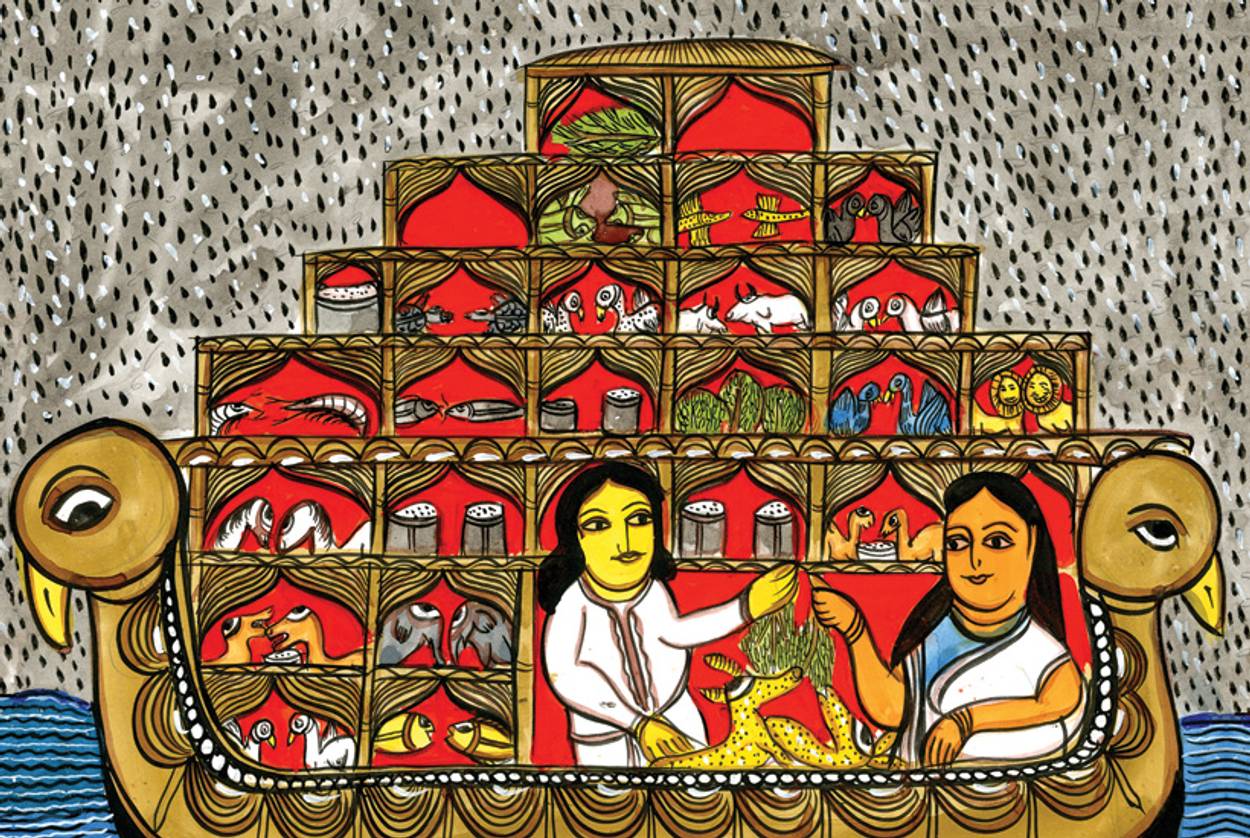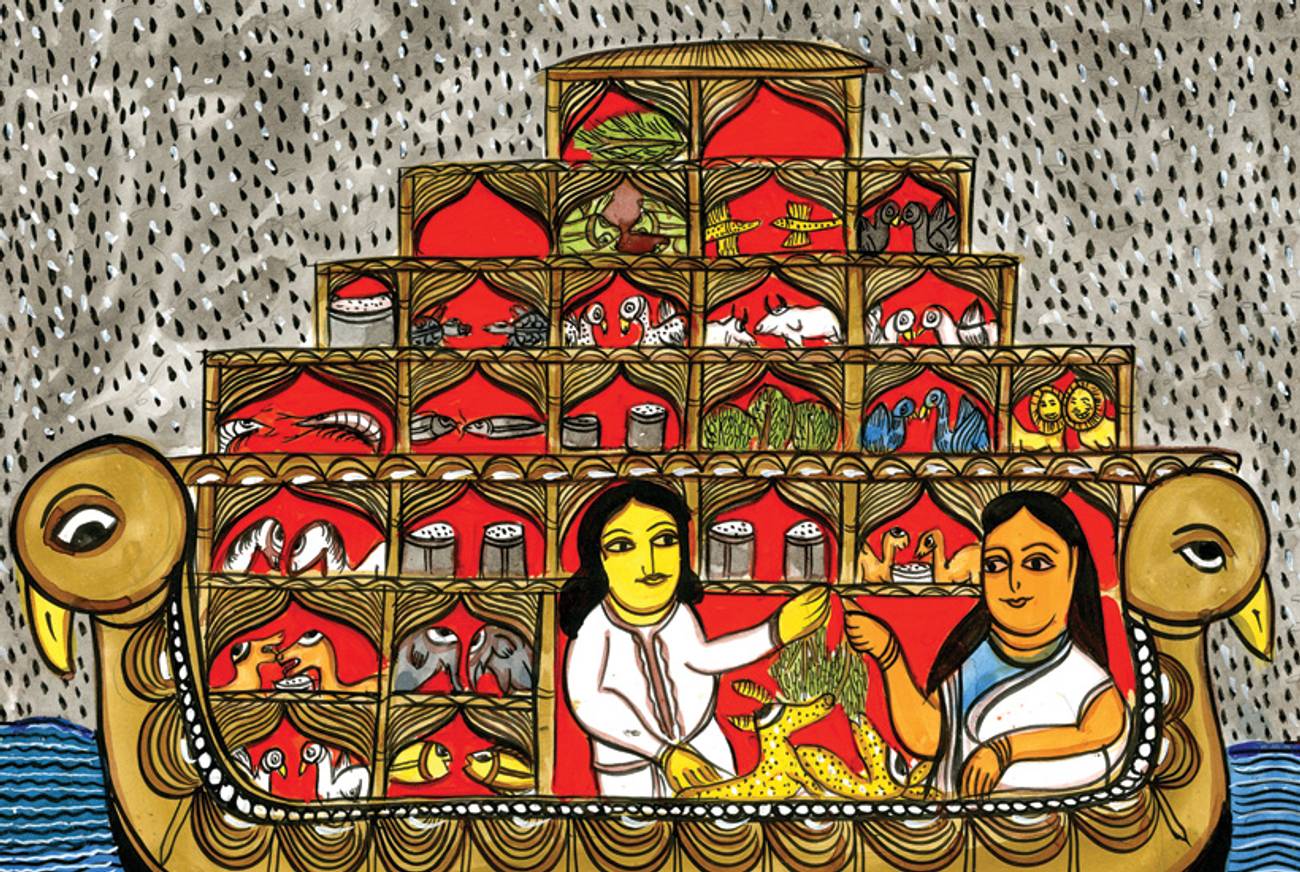A New Children’s Book Illustrates the Enduring Power of the Story of Noah
Offering an Indian twist on the Great Flood, The Enduring Ark finds universal themes in a biblical tale that resonates today




If you search for “Noah’s ark” under children’s books on Amazon, you’ll get 671 hits.
Both my kids were addicted to a board book version of Noah’s Ark by Lucy Cousins, creator of the ubiquitous little mouse who exists only in profile, Maisy. The book is colorful and full of adorable fluffy animals. (Yet I note that in our age of neurotic parenting, some Amazon reviewers were distressed that the text says that God made a flood to destroy the wicked people; why include that, they demanded, since it would be upsetting for their precious little flowers to read? To which I say: Uh, if you’re worried about upsetting your children, stay away from the Bible.)
Why is the Noah story so resonant, especially if it can be so scary? And with so many variations on the same story already available for children, do we really need another?
A new version of the tale helps answer these questions. The Enduring Ark by Joydeb Chitrakar and Gita Wolf gives Noah a Southeast Asian twist. The book is illustrated in the Bengal Patua style of scroll painting. Traditionally Bengali artists and songwriters traveled from home to home, unfurling a scroll of pictures that accompanied a chanted story, in a kind of narrative graphic art. The scroll was made from many panels of parchment stitched together and rolled up, inscribed with plant-based ink and employing tree gum as a binder. (Sound familiar?) The scrolls often tell stories of Hindu gods, but they can also tell stories of history, rules, or how to live. (Sound familiar, again?)
The technique continues today, though artists now may use store-bought inks and brushes and paper. The scroll is still filled with colorful imagery, usually with dark, heavy outlines and bright colors inside of and overflowing the lines. Old saris might be used as backing materials, providing additional texture, pattern, and richness. (Visually, it’s just a tad livelier than the Torah.)
This technique is adapted for The Enduring Ark. The book is made of one giant accordion fold, with images of water flowing from fold to fold. The first image shows a giant crying eye, with the tears turning into a river that flows like a border along the bottom of each page, rising as the flood waters do, taking up more and more of each fold as the waters sweep people away and the ark is stranded on the top of a mountain with water all around, and finally receding as the dove returns to Noah with an olive branch. The river then turns back into a border, and finally into the blue of the rainbow, soaring up into the sky. It’s truly lovely. The book’s visual style recalls illuminated Indian manuscripts, with their rounded shapes, heavy black lines, and boxed areas. Noah and his wife wear draped fabrics; the colors are electric blues, greens, yellows, and reds.
It’s hard to describe the way you read the book, but I’ll try: You have two choices. You can flip fold-to-fold until you get to the moment when the flood begins, then flip the entire section of folded pages back and start reading again on the flip-sides for the continuation of the story. (It’s more intuitive than it sounds.) Or you can unfold the whole thing at once, like a Torah on Simchat Torah, and read it all at a go that way. The structure works perfectly for the story itself—it proceeds like a flow of water, gentle at first and then scary and then gentle again. The first set of folds builds up to the terrible thing, and then the last set of folds leads to God’s covenant and a new world and the receding waters.
The Enduring Ark is published by Tara Books, an Indian company that seems particularly suited to a story of hope and renewal: It’s a collective, a co-op of writers and designers committed to feminist and egalitarian principles, respecting tribal and folk art. Tara runs a Tamil literacy initiative for kids and a cultural space in Chennai called The Book Building that hosts children’s events and exhibitions.
Is it really surprising that the story works in a Bengali context? Every culture is drawn to flood stories. Judaism, Christianity, Islam, and Baha’i all share the Noah story proper, and epics about floods in general appear in a zillion other traditions, including Indian ones … and don’t get me started on Gilgamesh, Greek mythology, or Mayan and Muisca lore. Adults of all cultures thrill to the evidence of the terrifying power of nature. We want to think we’re in charge, all-powerful beings. Natural disasters are quick to show us we’re not. What we build, floods and great winds destroy. The Noah story in the Torah offers the added frisson of a little PTSD-fueled drunkenness, nudity, and filial disrespect. The Torah story doesn’t end after the rainbow; it ends after Noah plants a vineyard, gets smashed, gets naked, and gets mocked (or worse?) by his son Ham. Again, the tale tells how scary a loss of control can be. It’s just like The Sorcerer’s Apprentice, if Mickey got plastered and had a creepy son.
The children’s version of the story leaves out the drunken nudity, of course. It turns the tale into one that’s just scary enough, one that builds suspense but ultimately soothes. We have God as an implacable, cataclysmic force, and Noah as a kind, care-taking daddy. We have a cozy cradle rocking on the ocean, full of animals that miraculously all get along, a tiny oasis of togetherness in the big scary world. We have a rainbow, one of the first things any child learns to draw, and a promise that grief and loss won’t happen again. Isn’t it pretty to think so?
The Noah story seems particularly potent today, since we seem to be entering a new time of environmental destruction. It seems we’ve broken our part of the covenant with God to be caretakers of the earth. Kids hear about hurricanes, tornadoes, and tsunamis so often these days, events that seem to have far more crippling force than they did when we were kids. When I read The Enduring Ark, I couldn’t help thinking of Hurricane Sandy, which caused huge flood damage and suffering in our city and in our own neighborhood. The destruction was an opportunity for tikkun olam—we made sandwiches for homeless shelters, dragged a wagon full of blankets and food to a church, helped Maxie’s school fund-raise for the victims. The way to feel less powerless is to be a helper, and that’s a wonderful message for children.
In 2014, Noach will be the parsha for Josie’s 13th-birthday weekend. With thoughts of this environmental catastrophe and how excellent it would be for her speech (because I’m shallow that way) I called the shul to book the date. Stupid me. This is New York City and I should have booked the date when she was a fetus. (She got Lech Lecha, which is an emotionally rich portion, too. I’m not complaining.) I’m maybe just a tad bummed that we won’t get to immerse ourselves (ahem) in this powerful story leading up to her bat mitzvah.
Children and adults may view the Noah story differently: For kids, it’s all about the Peaceable Kingdom, and for adults, it’s all about the unnerving, uncertain echoes of responsibility and parenting failure and loss, the choice to be hopeful even when we know there’s no end to bad stuff happening. It’s no accident that we fill our kids’ rooms with toy arks and cartoon-y books retelling the story in a kid-friendly way. As my mom, a professor emeritus of education at the Jewish Theological Seminary, said in a drash, “We surround the children we love with these books and decorations as talismans because, as Robert Coles reminds us, children are a mirror of ourselves, on whom we project our hopes for the future. I would add that we project our fears for the future on them as well. By soothing and reassuring them that rain will be followed by rainbows, we soothe and reassure ourselves.”
***
Like this article? Sign up for our Daily Digest to get Tablet Magazine’s new content in your inbox each morning.
Marjorie Ingall is a columnist for Tablet Magazine, and author of Mamaleh Knows Best: What Jewish Mothers Do to Raise Successful, Creative, Empathetic, Independent Children.
Marjorie Ingall is a former columnist for Tablet, the author of Mamaleh Knows Best, and a frequent contributor to the New York Times Book Review.